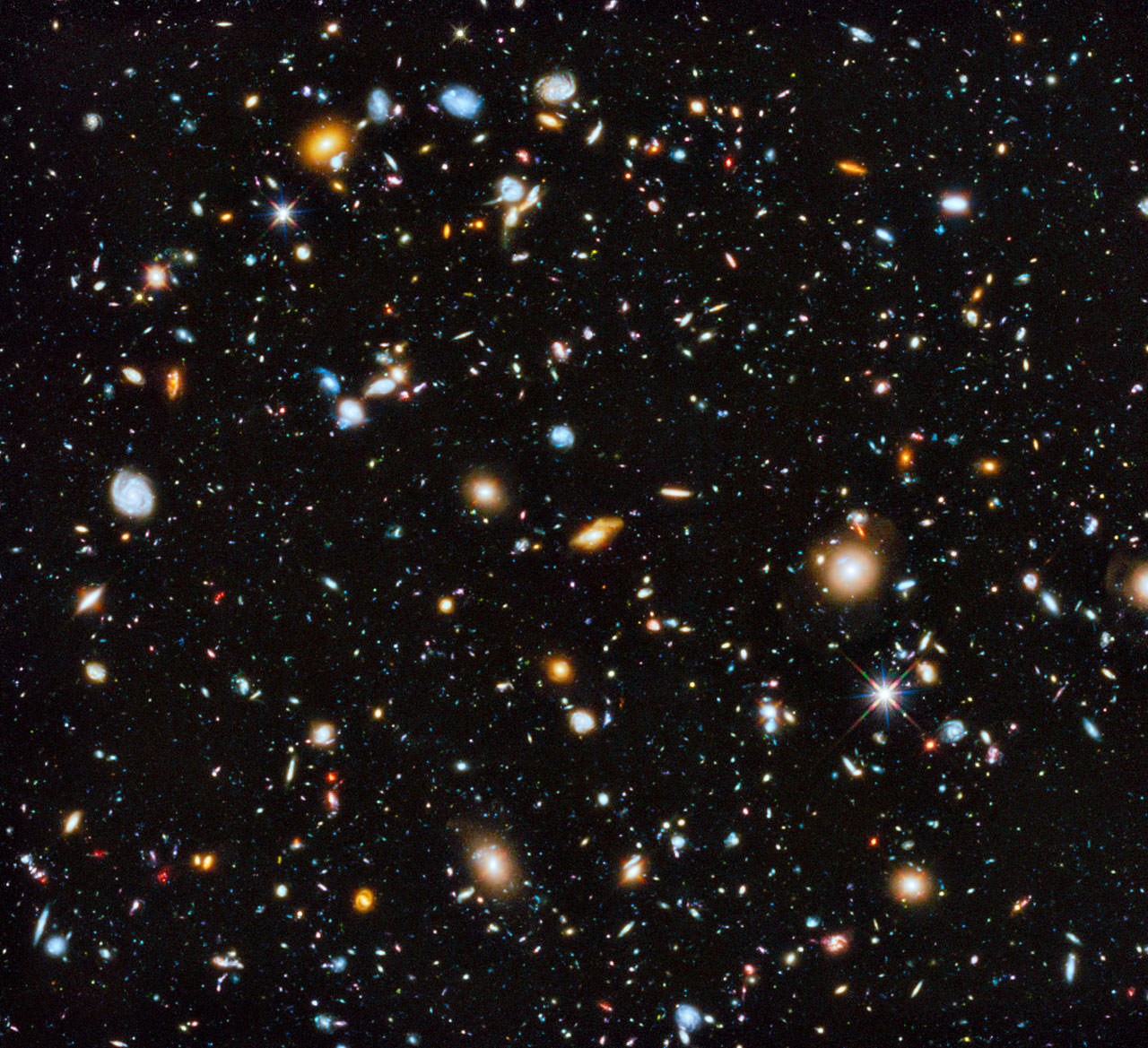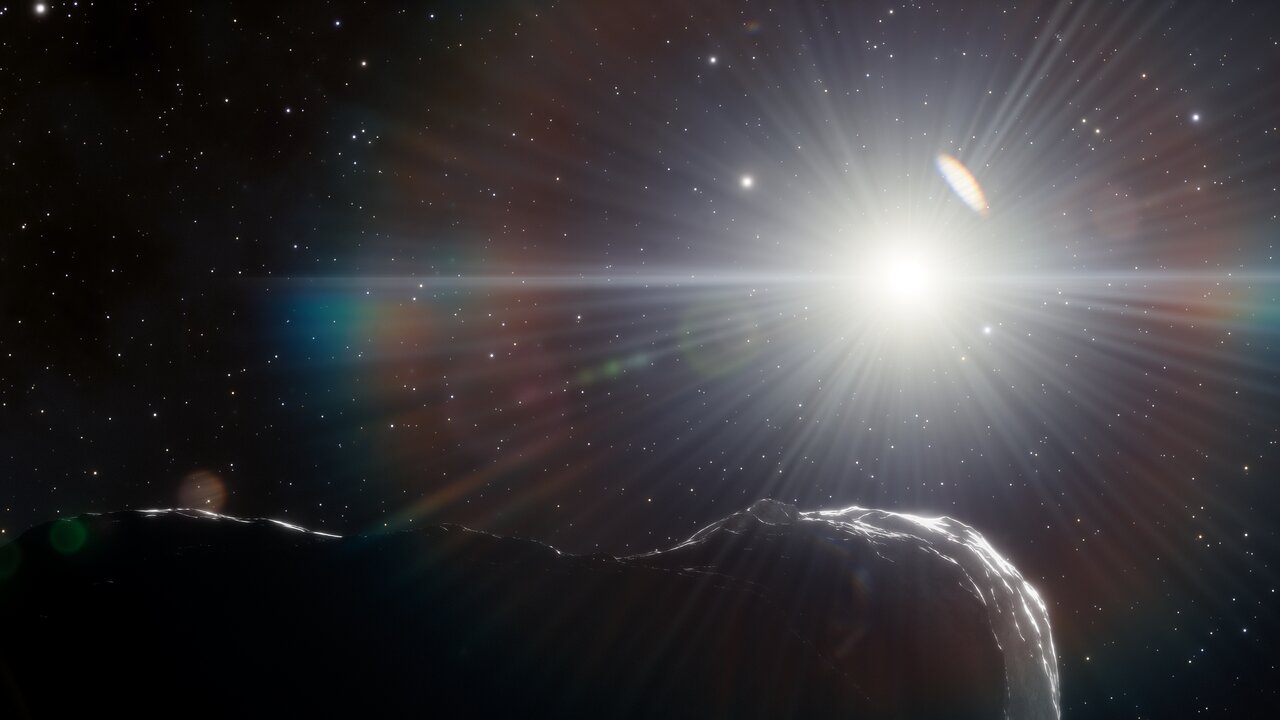We are all familiar with our one Moon but other planets have different numbers of moons; Mercury has none, Jupiter has 95 and Mars has two. A new paper proposes that Mars may actually have had a third larger moon. Why? The red planet has a triaxial shape which means it bulges just like Earth does but along a third axis. The paper suggests a massive moon could have distorted Mars into this shape.
Continue reading “Did Mars Once Have a Third, Larger Moon?”The Early Universe Had a Lot of Black Holes

The Hubble Deep Field and its successor, the Hubble Ultra-Deep Field, showed us how vast our Universe is and how it teems with galaxies of all shapes and sizes. They focused on tiny patches of the sky that appeared to be empty and revealed the presence of countless galaxies. Now, astronomers are using the Hubble Ultra-Deep Field and follow-up images to reveal the presence of a large number of supermassive black holes in the early Universe.
This is a shocking result because, according to theory, these massive objects shouldn’t have been so plentiful billions of years ago.
Continue reading “The Early Universe Had a Lot of Black Holes”SETI Scientists Scan TRAPPIST-1 for Technosignatures

If you are going to look for intelligent life beyond Earth, there are few better candidates than the TRAPPIST-1 star system. It isn’t a perfect choice. Red dwarf stars like TRAPPIST-1 are notorious for emitting flares and hard X-rays in their youth, but the system is just 40 light-years away and has seven Earth-sized worlds. Three of them are in the potentially habitable zone of the star. They are clustered closely enough to experience tidal forces and thus be geologically active. If intelligent life arises easily in the cosmos, then there’s a good chance it exists in the TRAPPIST-1 system.
Continue reading “SETI Scientists Scan TRAPPIST-1 for Technosignatures”A Star Was Kicked Out of a Globular Cluster by an Intermediate-Mass Black Hole

Astronomers have solid evidence for the existence of stellar-mass black holes and supermassive black holes. However, evidence for Intermediate Black Holes (IMBHs) is more elusive. Their existence remains hypothetical.
However, study by study, evidence is accumulating for IMBHs. The latest comes from the globular cluster M15, where a fast-moving star suggests the presence of something massive. Could it be an elusive IMBH?
Continue reading “A Star Was Kicked Out of a Globular Cluster by an Intermediate-Mass Black Hole”Astronomers Have Found a Star with a Hot Jupiter and a Cold Super Jupiter in Orbit

Located in the constellation Ursa Major, roughly 300 light-years from Earth, is the Sun-like star HD 118203 (Liesma). In 2006, astronomers detected an exoplanet (HD 118203 b) similar in size and twice as massive as Jupiter that orbits very closely to Liesma (7% of the distance between Earth and the Sun), making it a “Hot Jupiter.” In a recent study, an international team of astronomers announced the detection of a second exoplanet in this system: a Super Jupiter with a wide orbit around its star. In short, they discovered a “Cold Super-Jupiter” in the outskirts of this system.
Continue reading “Astronomers Have Found a Star with a Hot Jupiter and a Cold Super Jupiter in Orbit”Future Gravitational Wave Observatories Could See the Earliest Black Hole Mergers in the Universe
In February 2016, scientists at the Laser Interferometer Gravitational-wave Observatory (LIGO) confirmed they made the first-ever detection of gravitational waves (GWs). These events occur when massive objects like neutron stars and black holes merge, sending ripples through spacetime that can be detected millions (and even billions) of light-years away. Since the first event, more than 100 GW events have been confirmed by LIGO, the Advanced VIRGO collaboration, and the Kamioka Gravitational Wave Detector (KAGRA).
Moreover, scientists have found numerous applications for GW astronomy, from probing the interiors of supernovae and neutron stars to measuring the expansion rate of the Universe and learning what it looked like one minute after the Big Bang. In a recent study, an international team of astronomers proposed another application for binary black hole (BBH) mergers: using the earliest mergers in the Universe to probe the first generation of stars (Population III) in the Universe. By modeling how the events evolved, they determined what kind of GW signals the proposed Einstein Telescope (ET) could observe in the coming years.
Continue reading “Future Gravitational Wave Observatories Could See the Earliest Black Hole Mergers in the Universe”Could You Find What A Lunar Crater Is Made Of By Shooting It?
Americans are famously fond of their guns. So it should come as no surprise that a team of NASA scientists has devised a way to “shoot” a modified type of sensor into the soil of an otherworldly body and determine what it is made out of. That is precisely what Sang Choi and Robert Moses from NASA’s Langley Research Center did, though their bullets are miniaturized spectrometers rather than hollow metal casings.
Continue reading “Could You Find What A Lunar Crater Is Made Of By Shooting It?”There are Plenty of Uses for Powerful Lasers in Space. But Where Should We Put Them?

Is it time for space lasers yet? Almost.
As time passes, ideas that were once confined to the realm of science fiction become more realistic. It’s true of things like using robots to explore other worlds. Space lasers are a well-used element in science fiction, and we’re approaching the time when they could become a reality.
Where would we put them, and what could we use them for?
Continue reading “There are Plenty of Uses for Powerful Lasers in Space. But Where Should We Put Them?”There Could be a Way to Fix Spacecraft at L2, Like Webb and Gaia

Billions of dollars of observatory spacecraft orbit around Earth or in the same orbit as our planet. When something wears out or goes wrong, it would be good to be able to fix those missions “in situ”. So far, only the Hubble Space Telescope (HST) has enjoyed regular visits for servicing. What if we could work on other telescopes “on orbit”? Such “fixit” missions to other facilities are the subject of a new NASA paper investigating optimal orbits and trajectories for making service calls on telescopes far beyond Earth.
Continue reading “There Could be a Way to Fix Spacecraft at L2, Like Webb and Gaia”Could We Find Primordial Black Holes in the Solar System?
Astronomers have observed three types of black holes in the Universe. Stellar-mass black holes formed from the collapse of a massive star, intermediate mass black holes found in some star clusters, and supermassive black holes that lurk in the centers of galaxies. But there is a fourth type that remains hypothetical an unobserved. Known as primordial black holes, they are thought to have formed from tiny fluctuations in the hot and dense early cosmos. Since they wouldn’t have formed from stars or mergers, they could have a much smaller mass. And with small masses, primordial black holes would be tiny. Their event horizons would be smaller than an apple, perhaps as small as a grain of sand. You can see why they would be hard to find.
Continue reading “Could We Find Primordial Black Holes in the Solar System?”



